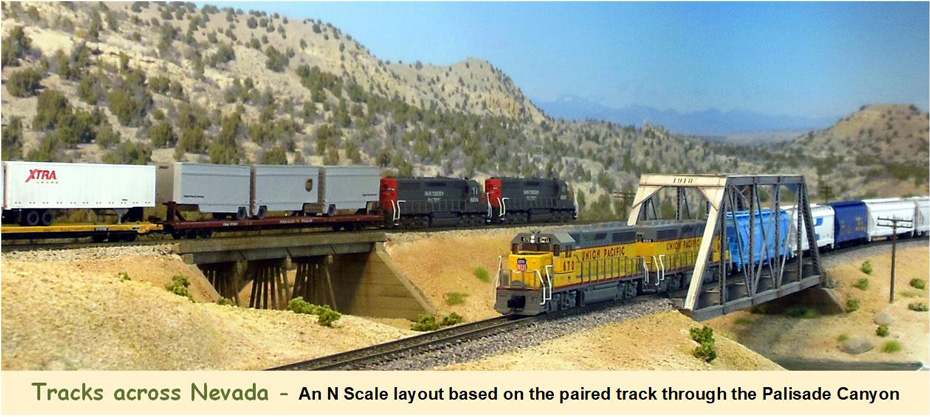In the next expansion of the layout I will need a bridge where the WP line again crosses the Humboldt River. The bridge that is actually in that location on the prototype is a 4 section through truss bridge. My bridge in going to have to be part of a curved section of track so I am going to use a ballasted deck, segmented concrete bridge. I already have a straight version of this type of bridge that I installed on the Golconda section in February of 2017 and is featured in THIS POST. For that bridge I had a couple of good prototype photos I was following. This bridge is going to be more freelanced. I had considered the BLMA kit which is similar to what I wanted but it was too short for my application so I decided to scratch build this one.
I started by making several bents using some of the poles from Rix Products highway bridge kits. These are 1/8 inch in diameter so I am only using 3 per bent. The horizontal beam is cut of pine strip with holes drilled into it for the poles so they are quite sturdy.
The curve is going to be 18 inch radius so using an 18 inch radius Tracksetta tool as a guide I marked out a curved section on a large sheet of .030 styrene sheet. Then I cut the curve out with a pair of scissors.
.030 thick styrene was cut into five 20 x 17 n scale foot sections and glued onto the curved strip. The outer edge has small gaps between the sections. The excess of the original curved sheet of styrene was cut off at each end. Then .060 x .060 L channel strip was glued along both edges to covers the gaps on the outer edge between the two sheets of .030 styrene.
The longitudinal beams were made from 1/8 inch Plastruct square tube stock cut into lengths that matched that section along the edges. To give the bridge deck some stiffness, short lengths of .040 music wire that had a slight bend were glued into the holes of the tube.
On the straight version of this type of bridge I had used 1/8 inch thick acrylic to make the bridge deck stiff but not being able to cut a curve in the acrylic I used 1/8 inch hard board. Between the music wire joints between the beam sections and the hard board the bridge deck got quite stiff.
.040 x .060 styrene strip was added along the top near the edges of the deck to retain track ballast. Bridge abutments of the correct height to match the adjoining sub roadbed plus the thickness of the cork were made from 1/4" plywood. All the pieces were painted with Model Master aged concrete acrylic paint.
The bottoms of the poles were cut and angled to sit on top of 1/8" thick footings on the bottom. The bridge is shown here set temporarily in place after all the parts were glued together and receiving some weathering. Once more of the surrounding terrain is built up and the river get at least a basic finish then it can be permanently glued in.















